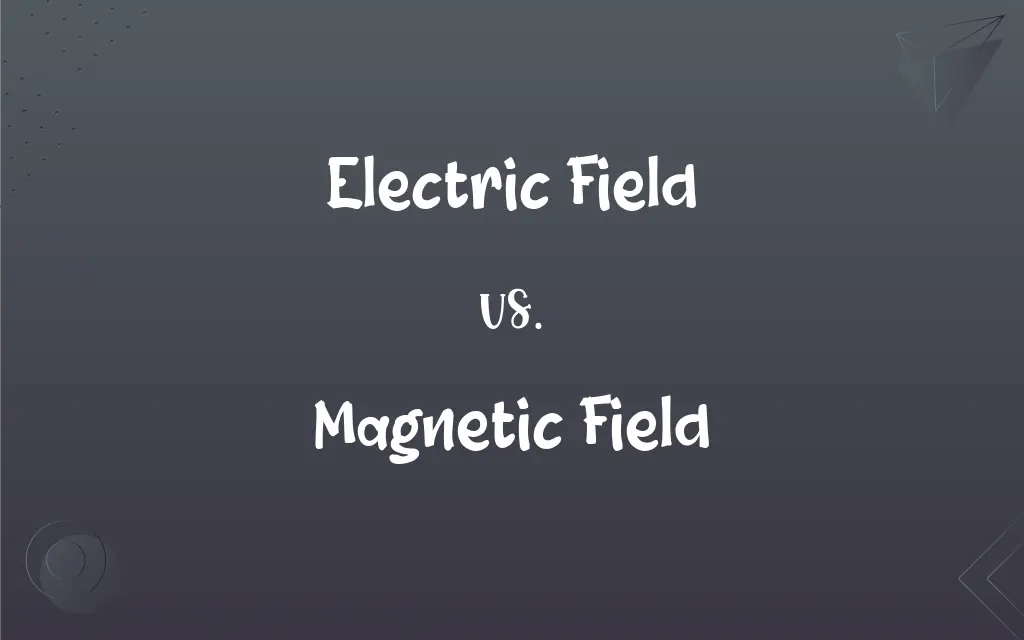Electric Field vs. Magnetic Field: What's the Difference?
Edited by Aimie Carlson || By Harlon Moss || Updated on October 20, 2023
An electric field arises from charged particles and exerts force on other charges, while a magnetic field originates from moving charges and affects other moving charges.

Key Differences
Electric fields and magnetic fields are both fundamental concepts in electromagnetism, but they have distinct origins and properties. An electric field is generated by stationary electric charges, such as those in a static buildup on a balloon. The electric field describes the force that a charge would experience if placed within it. In contrast, a magnetic field is typically produced by moving electric charges, like the flow of current in a wire. A magnetic field dictates the force experienced by moving charges within its vicinity.
The interactions of electric fields and magnetic fields with charges are different. An electric field will exert a force on any electric charge, whether stationary or moving, placed within its domain. The force is directly proportional to the magnitude of the charge. On the other hand, a magnetic field will only influence a charge if that charge is in motion. The force is proportional to both the charge's velocity and its magnitude.
Another distinction between electric fields and magnetic fields lies in their directionality. The direction of the electric field is always from positive to negative charges. However, the direction of the magnetic field is determined by the right-hand rule, which is perpendicular to the direction of the current that generates it.
In certain situations, electric fields and magnetic fields can interconvert. According to Faraday's law of electromagnetic induction, a changing magnetic field can induce an electric field. Conversely, according to Ampère's law, a changing electric field can generate a magnetic field. Both these phenomena are fundamental to the operation of many electrical devices, from generators to transformers.
Comparison Chart
Source
Stationary electric charges.
Moving electric charges (current).
ADVERTISEMENT
Interaction with Charges
Affects both stationary and moving charges.
Affects only moving charges.
Directionality
From positive to negative charges.
Determined by the right-hand rule and is perpendicular to the current.
Units
Newtons per Coulomb (N/C) or Volts per meter (V/m).
Tesla (T) or Gauss (G).
Examples
Electric field around a charged balloon.
Magnetic field around a current-carrying wire.
Electric Field and Magnetic Field Definitions
Electric Field
Electric fields determine the electric force on a charge placed within them.
The stronger the electric field, the greater the force on a test charge.
ADVERTISEMENT
Magnetic Field
Magnetic fields can affect the motion of charged particles.
The magnetic field bends the path of charged particles in a cathode ray tube.
Electric Field
Electric fields can be generated by electric potentials or voltages.
The electric field between the plates of a capacitor is uniform.
Magnetic Field
The direction of a magnetic field is given by the right-hand rule for currents.
The magnetic field circles around a current in the direction given by the right-hand rule.
Electric Field
An electric field is a region around a charged particle where electric forces can be felt.
The electric field around a charged plate pushes other charges away.
Magnetic Field
A magnetic field is a region where magnetic forces can be experienced by moving charges.
The magnetic field around a bar magnet attracts iron filings.
Electric Field
Electric fields can be either attractive or repulsive, depending on the charges involved.
Opposite charges create an attractive electric field between them.
Magnetic Field
Magnetic fields arise from moving electric charges or inherent magnetic moments.
A current-carrying coil generates a magnetic field around it.
Electric Field
The direction of an electric field is always from positive to negative charges.
The electric field arrows point away from positive charges.
Magnetic Field
Earth has a natural magnetic field, which is why compasses work.
The compass needle aligns with the Earth's magnetic field.
FAQs
Does a magnetic field affect stationary charges?
No, a magnetic field only affects moving charges.
What creates an electric field?
Stationary electric charges generate an electric field.
Do all moving charges generate a magnetic field?
Yes, any moving electric charge produces a magnetic field.
How can you ascertain the direction of a magnetic field around a current?
The right-hand rule gives the direction of the magnetic field around a current.
Why do compasses point north?
Compasses align with the Earth's magnetic field, which points towards the magnetic north.
How does a changing magnetic field generate an electric field?
Through Faraday's law of electromagnetic induction, a changing magnetic field induces an electric field.
Can you shield against electric or magnetic fields?
Electric fields can be shielded using conductors, while magnetic fields require specific materials like mu-metal for shielding.
How is a magnetic field produced?
Moving electric charges, like current in a wire, create a magnetic field.
Can electric fields store energy?
Yes, energy can be stored in capacitors due to the electric field between the plates.
Why do charged particles spiral in a magnetic field?
The magnetic force acts perpendicular to the particle's velocity, causing it to spiral.
How are magnetic fields used in MRI machines?
MRI machines use strong magnetic fields to align and then detect signals from hydrogen nuclei in the body.
Can an electric field affect a moving charge?
Yes, an electric field exerts a force on both stationary and moving charges.
How do you determine the direction of an electric field?
The direction of the electric field is from positive to negative charges.
What unit measures the electric field?
The electric field is measured in Newtons per Coulomb (N/C) or Volts per meter (V/m).
Can electric fields pass through conductors?
Electric fields inside conductors are usually zero when at electrostatic equilibrium.
Are the Earth's electric and magnetic fields connected?
Yes, the Earth's electric and magnetic fields are interrelated, especially in phenomena like auroras.
Can electric fields and magnetic fields influence each other?
Yes, changing electric fields can produce magnetic fields and vice versa.
Which unit is used for magnetic fields?
The magnetic field is measured in Tesla (T) or Gauss (G).
Are electric fields always repulsive?
No, electric fields can be either attractive or repulsive, depending on the charges involved.
What's the relationship between electric field, voltage, and distance?
Electric field (E) is the voltage (V) divided by the distance (d) or E = V/d.
About Author
Written by
Harlon MossHarlon is a seasoned quality moderator and accomplished content writer for Difference Wiki. An alumnus of the prestigious University of California, he earned his degree in Computer Science. Leveraging his academic background, Harlon brings a meticulous and informed perspective to his work, ensuring content accuracy and excellence.
Edited by
Aimie CarlsonAimie Carlson, holding a master's degree in English literature, is a fervent English language enthusiast. She lends her writing talents to Difference Wiki, a prominent website that specializes in comparisons, offering readers insightful analyses that both captivate and inform.
































































